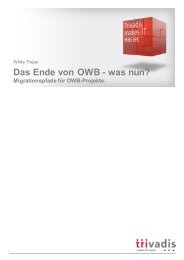phsjhxx
phsjhxx
phsjhxx
You also want an ePaper? Increase the reach of your titles
YUMPU automatically turns print PDFs into web optimized ePapers that Google loves.
BEGIN<br />
FOR i IN 1..3<br />
LOOP<br />
dbms_output.put_line('in loop');<br />
END LOOP;<br />
--<br />
IF 1 = 1<br />
THEN<br />
dbms_output.put_line('yes');<br />
END IF;<br />
--<br />
dbms_output.put_line('end');<br />
END;<br />
For a single program (or subroutine or method), P is always equal to 1. Cyclomatic<br />
complexity may, however, be applied to several such programs or subprograms at the same<br />
time (e.g., to all of the methods in a class), and in these cases P will be equal to the number<br />
of programs in question, as each subprogram will appear as a disconnected subset of the<br />
graph.<br />
It can be shown that the cyclomatic complexity of any structured program with only one<br />
entrance point and one exit point is equal to the number of decision points (i.e., 'if'<br />
statements or conditional loops) contained in that program plus one.<br />
Cyclomatic complexity may be extended to a program with multiple exit points; in this case<br />
it is equal to:<br />
where π is the number of decision points in the program, and s is the number of exit points.<br />
6.2.2 CodeXpert<br />
A common application of cyclomatic complexity is to compare it against a set of threshold<br />
values. The calculation of the cyclomatic complexity can be done using CodeXpert for<br />
example.<br />
Analysis Result<br />
The table below shows the threshold values used by CodeXpert:<br />
Cyclomatic Risk Evaluation<br />
Complexity<br />
1 – 10 A simple program, without much risk<br />
11 – 20 A more complex program, with moderate risk.<br />
21 – 50 A complex, high risk program.<br />
> 50 An un-testable program with very high risk.<br />
PL/SQL Coding Guidelines 49




